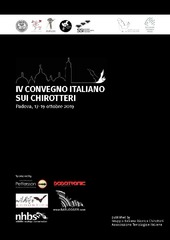Приказ основних података о документу
Artificial illumination near rivers may alter bat-insect trophic interactions
| dc.creator | Russo, Danilo | |
| dc.creator | Consentino, Francesca | |
| dc.creator | Festa, Francesca | |
| dc.creator | De Benedetta, Flavia | |
| dc.creator | Bajić, Branka | |
| dc.creator | Cerretti, Pierfilippo | |
| dc.creator | Ancillotto, Leonardo | |
| dc.date.accessioned | 2021-07-23T10:43:34Z | |
| dc.date.available | 2021-07-23T10:43:34Z | |
| dc.date.issued | 2019 | |
| dc.identifier.uri | https://www.mammiferi.org/wp-content/uploads/2019/03/gircmammiferi-org/2019/03/GIRC2019_web_compressed-2.pdf | |
| dc.identifier.uri | https://radar.ibiss.bg.ac.rs/handle/123456789/4267 | |
| dc.description.abstract | Artificial lighting at night (ALAN) has undergone a broad and rapid expansion. By altering natural environmental lighting, ALAN significantly interferes with some key aspects of animal physiology and ecology. Bats, as obligate nocturnal taxon, are very sensitive to ALAN, and so are the insects they feed on: thus, the presence of artificial light may have direct effects on different bat behaviors such as foraging, drinking, commuting, emergency, and roosting. Insect attraction to light also leads more opportunistic bat species to use illuminated foraging sites, which alters their normal routes and exposes them to a greater risk of predation. In freshwater ecosystems, this alteration may have massive repercussions on the trophic relationship between foraging bats and their insect prey. We used bats and their insect prey as models to investigate the effects of LED lighting on prey-predator interactions at riverine ecosystems. The experiment was carried out by installing a portable LED outdoor lamp on a bank along the river Sangro and its tributary stream Zittola (Abruzzo, Lazio and Molise National Park), in summer 2017. We compared through a paired design bat and insect reactions in terms of bat activity and prey insect abundance and diversity, respectively, on artificially lit vs. unlit nights. We surveyed bat activity at each sampling point with stationary, automatically triggered D500X bat detectors, and sampled insects using sticky traps placed transversally along the river channel, 4 for each site and treatment, for 3 hours after sunset. We used generalized linear mixed models to test for the effect of artificial illumination at night on bat activity and adopted paired Student t-tests to examine differences in insect abundance under dark and light conditions. We also calculated a BrayCurtis dissimilarity index to look at changes in insect assemblage composition at family level between the two conditions, and used non-metric multidimensional scaling (NMDS) to analyse insect assemblage composition among sites and conditions. Finally, we conducted a two-way analysis of similarity to test whether insect assemblages differed under different light conditions, sites and trap positions. Our experiment shows that artificial light influenced both insect and bat assemblages in taxon-specific directions. Total bat activity showed a significant decrease under lit conditions, but this change was mainly due to the response of Myotis daubentonii, the most abundant species at the sites we investigated, while light-opportunistic species showed no reaction or even an opposite pattern as in the case of Pipistrellus kuhlii. The total number of sampled insects, especially that of dipterans, had a significantly increase under lit conditions. Moreover, insect assemblage composition differed between dark and lit conditions. The increase of insects under artificial illumination mainly concerned Chironomidae, typical Myotis daubentonii prey, therefore the decline in activity we observed in this species is best explained as direct avoidance of artificial lighting rather than a food-induced reaction. In fact, M. daubentonii is a relatively slow flier and mostly moves along rivers when hunting, so artificial light at night may act as a barrier fragmenting this species’ foraging habitat and increasing vulnerability to predation. On the other hand, the increase in P. kuhlii activity we observed on light sessions was most likely due to the increase in small dipterans which concentrated especially near the light, since the latter had the effect of promoting prey availability along riparian vegetation, the optimal foraging habitat for this edge specialist. We conclude that ALAN affects adversely some bat species, whereas others exploit the greater availability of insects near light sources. ALAN also implies qualitative and quantitative alterations of insect assemblages, overall potentially altering prey-predator interactions, which in turn implies changes in ecosystem functions and dynamics. | sr |
| dc.language.iso | en | sr |
| dc.publisher | Gruppo Italiano Ricerca Chirotteri – Associazione Teriologica Italiana | sr |
| dc.rights | openAccess | sr |
| dc.source | IV convegno italiano sui chirotteri; 2019 Oct 17-19; Padova, Italy | sr |
| dc.title | Artificial illumination near rivers may alter bat-insect trophic interactions | sr |
| dc.type | conferenceObject | sr |
| dc.rights.license | ARR | sr |
| dcterms.abstract | Руссо, Данило; Цонсентино, Францесца; Феста, Францесца; Де Бенедетта, Флавиа; Пејић, Бранка; Церретти, Пиерфилиппо; Aнциллотто, Леонардо; | |
| dc.rights.holder | ©2019 Associazione Teriologica Italiana onlus | sr |
| dc.description.other | IV convegno italiano sui chirotteri; 2019 Oct 17-19; Padova, Italy. Gruppo Italiano Ricerca Chirotteri – Associazione Teriologica Italiana; 2019. p. 29. | sr |
| dc.citation.spage | 29 | |
| dc.type.version | publishedVersion | sr |
| dc.identifier.fulltext | https://radar.ibiss.bg.ac.rs/bitstream/id/8550/bitstream_8550.pdf | |
| dc.citation.rank | M64 | |
| dc.identifier.rcub | https://hdl.handle.net/21.15107/rcub_ibiss_4267 |

